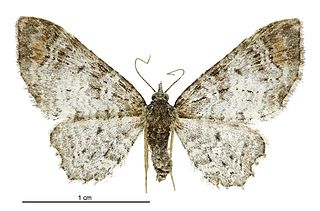
Agonopterix angelicella is a moth of the family Depressariidae. It is found in most of Europe, except the Iberian Peninsula and south-eastern Europe. It is also found on the Russian plain and Siberia and in Japan.

Pasiphila aristias is a species of moth in the family Geometridae. It was described by Edward Meyrick in 1897 and is endemic to New Zealand. This species is found in both the North and South Islands and inhabits subalpine and native forest. Adults are on the wing in December and January and are attracted to light.

Chersadaula ochrogastra is a species of moth in the family Oecophoridae. This species is endemic to New Zealand. It is classified as "Data Deficient" by the Department of Conservation.
Garrha amata is a moth in the family Oecophoridae. It was described by Edward Meyrick in 1914. It is found in Australia, where it has been recorded from Western Australia.
Machimia eothina is a moth in the family Depressariidae. It was described by Edward Meyrick in 1920. It is found in French Guiana.
Gelechia epiphloea is a moth of the family Gelechiidae first described by Edward Meyrick in 1913. It is found in South Africa.
Schizovalva rhodochra is a moth of the family Gelechiidae. It was described by Edward Meyrick in 1913. It is found in South Africa.
Aristotelia cytheraea is a moth of the family Gelechiidae. It was described by Edward Meyrick in 1917. It is found in Colombia.
Aristotelia subrosea is a moth of the family Gelechiidae. It was described by Edward Meyrick in 1914. It is found in Guyana.
Epiphractis aulica is a moth of the family Oecophoridae. This species was described from South Africa.
Cerconota rosacea is a moth of the family Depressariidae. It is found in the Amazon region and French Guiana.
Gonada rubens is a moth of the family Depressariidae. It is found in French Guiana.
Echiomima viperina is a moth in the family Xyloryctidae. It was described by Edward Meyrick in 1915. It is found in Australia, where it has been recorded from Queensland.
Gonada is a moth genus of the family Depressariidae.
Mimozela is a monotypic moth genus in the family Depressariidae. Its only species, Mimozela rhoditis, is found in Australia, where it has been recorded from Queensland. Both the genus and species were first described by Edward Meyrick in 1914.
Gonada phosphorodes is a moth in the family Depressariidae. It was described by Edward Meyrick in 1922. It is found in French Guiana.
Octasphales chorderes is a moth in the family Depressariidae. It was described by Edward Meyrick in 1902. It is found in Australia, where it has been recorded from Queensland.
Gonionota erotopis is a moth in the family Depressariidae. It was described by Edward Meyrick in 1926.
Hypercallia alexandra is a moth in the family Depressariidae. It was described by Edward Meyrick in 1909. It is found in Peru.
Anchinia porphyritica is a moth in the family Depressariidae. It was described by Edward Meyrick in 1914. It is found in Assam, India.


